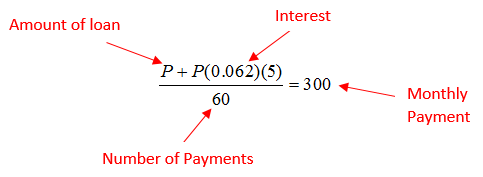When you have an add-on loan, the interest on the loan is a percentage of the original amount. Payments are calculated on the loan amount plus the interest (add-on!)
Let’s look at an example.
Problem 1 Suppose you want to purchase a car for 21,000 dollars with add-on interest at an annual interest rate of 6.2%. If you make monthly payments for 5 years, what will your monthly payment be?
Solution Start by calculating the interest you will pay using I = Prt. Since the amount of the loan is 21,000 dollars, P = 21,000. Using the rate (r = 0.062) and the time (t = 5), we get
I = (21000)(0.062)(5) = 6510
This means that we will pay 6510 dollars in interest along with the original 21,000 dollars back to the lender.
Amount paid back = 21,000 + 6510 = 27510
We are going to spread this out over 5 years with monthly payments (total of 60 payments). The amount of each of these payments is
Rounded to the nearest penny.
Now let’s look at how a down payment on a loan affects the payment. A down payment reduces the amount of the loan leading to a lower payment.
Problem 2 Suppose you want to purchase a car for 21,000 dollars with add-on interest at an annual interest rate of 6.2%. To lower the payments, you make a down payment of 5000 dollars. If you make monthly payments for 5 years, what will your monthly payment be?
Solution A down payment of 5000 dollars on a 21,000 dollars purchase lowers the amount you borrow to 16,000 dollars (P = 16,000). Using the rate (r = 0.062) and the time (t = 5), we get
I = (16000)(0.062)(5) = 4960
This means that we will pay 4960 dollars in interest along with the original 21,000 dollars back to the lender.
Amount paid back = 16,000 + 4960 = 20960
We are going to spread this out over 5 years with monthly payments (total of 60 payments). The amount of each of these payments is
Rounded to the nearest penny. As expected, the payment has gone down compared to Problem 1 above.
Now let’s get real…let’s figure out how much we would need to put down to lower the payment to 400 dollars.
Problem 3 Suppose you want to purchase a car for 21,000 dollars with add-on interest at an annual interest rate of 6.2%. To lower the monthly payment to 300 dollars, you need to make a down payment. If you make monthly payments for 5 years, what will your down payment need to be?
Solution The key to this problem is to understand what the loan amount needs to be to lower the payment to 400 dollars. This means P is our unknown and we want have a monthly payment of 400 dollars:
To solve this equation, multiply both sides of the equation by 60:
P + P (0.062)(5) = 300 × 60
Now let’s do a little simplifying. We can multiply 0.062 × 5 = 0.31 and 400 × 60 = 18000 to give
P + 0.31P = 18000
1.31P = 18000
P = 13740.46
The price of the car is 21,000 dollars and the amount to be borrowed is 13740.46 dollars, the down payment must be
Down payment = 21000 – 13740.46 = 7259.54
As you might guess, to lower your payment even more requires a bigger down payment.




